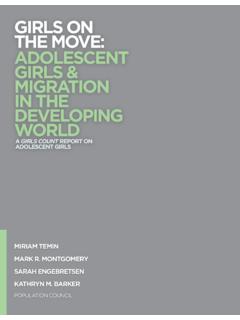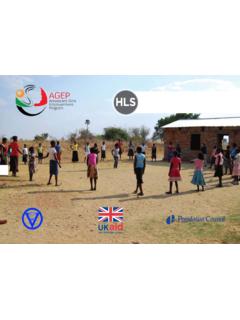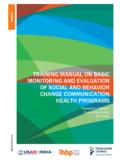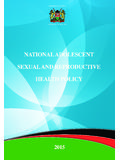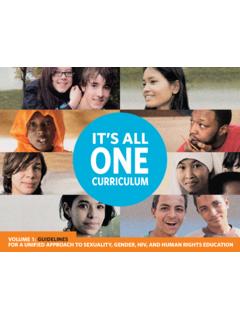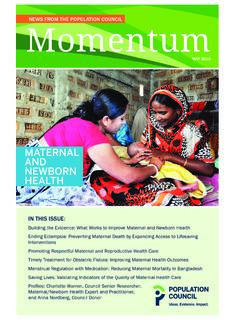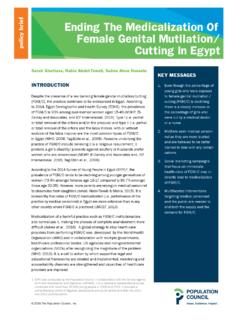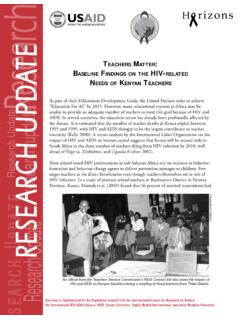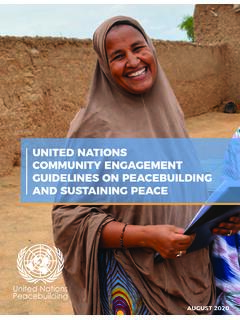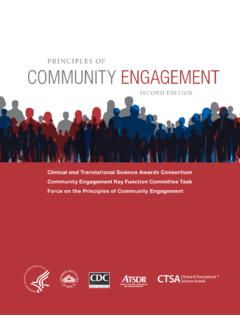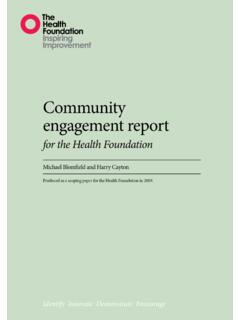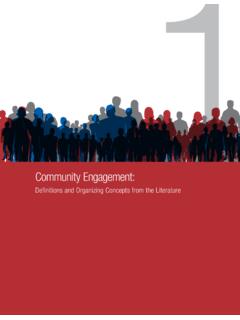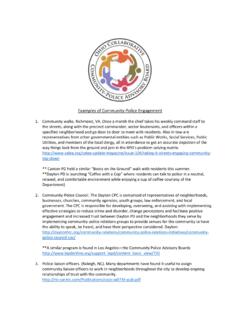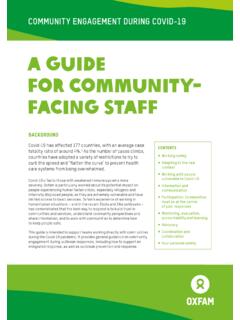Transcription of COMMUNITY ENGAGEMENT IN SGBV PREVENTION AND …
1 COMMUNITY ENGAGEMENT IN SGBV PREVENTION AND RESPONSE A Compendium of Interventions in the East & Horn of Africa and the Great Lakes Region Zahra Mirghani, Joanina Karugaba, Nicholas Martin-Achard UNHCR Chi-Chi Undie, Harriet Birungi Population Council The UN Refugee Agency (UNHCR) is the United Nations programme mandated to provide international protection and support to refugees. In line with this mandate, UNHCR is committed to ending all forms of SGBV in humanitarian settings. UNHCR works alongside displaced communities and with different partners across a wide range of sectors to prevent SGBV and to ensure support is available for survivors. The Population Council confronts critical health and development issues from stopping the spread of HIV to improving reproductive health and ensuring that young people lead full and productive lives. Through biomedical, social science, and public health research in 50 countries, we work with partners to deliver solutions that lead to more effective policies, programs, and technologies that improve lives around the world.
2 Established in 1952 and headquartered in New York, the Council is a non-governmental, non-profit organization governed by an international board of trustees. Suggested citation: Mirghani Z., Karugaba J., Martin-Archard N., Undie C., and Birungi H. 2017. COMMUNITY ENGAGEMENT in SGBV PREVENTION and Response: A Compendium of Interventions in the East & Horn of Africa and the Great Lakes Region. Nairobi, Kenya: Population Council. @2017 The Population Council Inc. TABLE OF CONTENTS Introduction .. 1 Overview of UNHCR s SGBV Strategy .. 1 COMMUNITY -Based Approach to SGBV PREVENTION and Response .. 2 Workshop Overview .. 3 COMMUNITY ENGAGEMENT in SGBV PREVENTION and Response: A Compendium of Interventions .. 5 PREVENTION , Identification, and Response to SGBV .. 5 Psychosocial Interventions for IPV Survivors .. 6 Youth Pyramid Structure .. 7 Outreach Volunteers Programme .. 8 SASA! Approach .. 8 The Protection of Children .. 9 Protection Learning Programme Anti-FGM Initiative.
3 9 Engaging Men and Boys .. 9 Engaging Men in Accountable Practices .. 10 Engaging Religious Leaders on FGM .. 11 Providing Safe Environments .. 12 Women and Girls Empowerment .. 13 Guidance for Effective Adoption of COMMUNITY ENGAGEMENT in SGBV Protection and Response .. 14 SGBV Issues Requiring Further Attention .. 15 Final Thoughts .. 19 Annex 1: Workshop Agenda .. 20 Annex 2: Attendance List .. 22 Annex 3: Compendium of SGBV Protection and Response Approaches .. 24 Annex 4: Possible Areas of Interest for Anti-SGBV Initiatives .. 26 1 INTRODUCTION This document captures efforts by UNHCR and its partners in promoting COMMUNITY ENGAGEMENT in combating sexual and gender-based violence (SGBV) in the region. The compendium of tools reflected here is drawn from the responses of several actors to various forms of SGBV. The diversity of these efforts involves a range of demographic groups (in terms of gender and age), geographic contexts (rural, urban), and intended outcomes (SGBV PREVENTION , response, or both).
4 The interventions described are also at various stages of development or maturity, and varied in scope, with a few having been properly documented and assessed in humanitarian settings. A review of these approaches provides important insights, and highlights opportunities for strengthening programming. It is hoped that this compendium will enhance advocacy for further support, and lead to greater and more sustainable impact. Overview of UNHCR s SGBV Strategy Conflicts and natural disasters create conditions where women, men, girls and boys are vulnerable to Sexual and Gender-Based Violence (SGBV). SGBV includes acts or threats of acts which inflict physical, mental, or sexual harm or suffering, or related deprivations of liberty on the basis of gender. SGBV can have severe and long lasting consequences for survivors, their families and societies. At the level of the survivor, immediate health consequences include reproductive health impacts, injury, and a myriad of other negative effects which may even lead to death.
5 SGBV is a violation of the human rights of those against whom violence is perpetrated. UNHCR adopts a rights-based approach in its efforts to prevent and respond to SGBV. These efforts include advocacy and programmatic interventions highlight and protect the rights of refugees, minimize the risk and exposure of refugees to SGBV and to maximize recovery from SGBV. Notably, UNHCR has elaborated a specific strategy for action (updated in June 2011) against SGBV in humanitarian settings. The strategy includes recommended actions in three focus areas, in order to strengthen UNHCR s capacity and expertise in addressing SGBV: 1) Data collection and analysis: Improve the quality of programmes by adopting and maintaining appropriate SGBV data collection and analysis tools and working with institutions and partners on researching and documenting SGBV. 2 2) Knowledge management and capacity-building: Strengthen the management of SGBV programmes by investing in capacity-building and expertise across the organisation.
6 3) Partnerships and coordination: Working with UN agencies, governments, non-governmental organisations (NGOs) and displaced communities, strengthen SGBV PREVENTION , response and coordination mechanisms for effective service delivery. COMMUNITY -Based Approach to SGBV PREVENTION and Response UNHCR adopts a rights-based approach to its work with persons of concern. These rights include the right of every person to participate in deciding and shaping their lives. Through the application of an Age, Gender and Diversity Approach (AGD) UNHCR aspires to ensure that these rights are accessible to all persons of concern on an equal footing. In addition, UNHCR recognizes that external input alone cannot deliver sustainable results for persons of concern. Protection and response strategies are more effective when they are designed, implemented and monitored with the meaningful ENGAGEMENT of refugees in all stages of the process. The COMMUNITY -based approach is therefore an integral aspect of the UNHCR framework for action on SGBV.
7 The approach shifts the focus from individual service delivery to enhancing the capacities of people of concern and their communities to be active agents in their own protection. By so doing, protection strategies are improved and people of concern are recognized as resources and rights-holders, rather than as passive beneficiaries of services. Zahra Mirghani, setting the stage. 3 Workshop Overview With this background in mind, the UNHCR Regional Services Center in Nairobi and the Population Council convened a dissemination workshop entitled Engaging Communities in SGBV PREVENTION and Response in Humanitarians Settings (see Annex 1 for workshop programme). The meeting served as a platform for sharing and learning from regional initiatives introduced to boost COMMUNITY ENGAGEMENT in SGBV protection and to reduce the occurrence and consequences of SGBV in humanitarian settings. The meeting took place from 17 to 19 October, 2016 in Nanyuki, Kenya.
8 Approximately 50 experts participated in the workshop, comprising SGBV focal points from UNHCR as well as national and international NGO staff. A total of 13 countries in the region were represented (see Annex 2 for details of participants). The objectives of the workshop were to: Take stock of, and reflect upon, the various COMMUNITY -based SGBV initiatives applied in UNHCR s field operations; Promote the utilization of new, evidence-based SGBV initiatives in UNHCR s programming; Strengthen promising field initiatives by enhancing understanding of principles of effective COMMUNITY ENGAGEMENT ; and Strengthen and facilitate regional technical exchange and information-sharing around COMMUNITY ENGAGEMENT in SGBV among UNHCR and partners. As the PREVENTION of, identification of, and response to, SGBV are noted as cross-cutting strategies in UNHCR s action plan, the workshop centered on initiatives related to these areas. In addition, the workshop focused on 5 out of 6 action areas identified by UNHCR to enhance the quality of protection and improve services for specific at-risk populations from 2011-2016.
9 The specific action areas highlighted during the workshop include: o The protection of children (which includes the PREVENTION of and responses to sexual violence and harmful traditional practices, such as early marriage); o Addressing survival sex as a coping mechanism; o Engaging men and boys; o Providing safe environments and access to domestic energy; o Protecting LGBTI persons of concern. The remainder of this report delves into a description of recent UNHCR interventions geared toward: 1) the PREVENTION , identification, and/or response to SGBV, and 2) addressing UNHCR s identified action areas for selected at-risk populations. It is noteworthy that specific action areas for which there were no actual programming examples presented at the workshop ( , Meeting participants in Nanyuki, Kenya. 4 Addressing survival sex as a coping mechanism and Protecting LGBTI persons of concern ) are not highlighted in the compendium of interventions.
10 However, these topics were addressed at the workshop through sensitization presentations by UNHCR (see Annex 1 for the Meeting Agenda). Furthermore, interventions around these areas do exist in UNHCR s Kenya Operation, for instance. 5 COMMUNITY ENGAGEMENT IN SGBV PREVENTION AND RESPONSE: A COMPENDIUM OF INTERVENTIONS In response to the need for a COMMUNITY -based approach which undergirds UNHCR s strategy for action against SGBV, UNHCR and its partners have devoted efforts to developing (or adapting) and implementing innovative approaches to COMMUNITY -based SGBV PREVENTION and These approaches include a variety of evidence-based and untested (yet, promising) interventions. This compendium showcases a mix of tested and untested models. PREVENTION , Identification, and Response to SGBV Routine Screening for SGBV in Health Facilities A growing body of evidence points to the utility of routine screening for promoting the identification of SGBV survivors as well as survivors access to comprehensive services.
